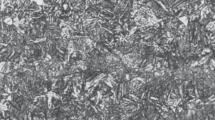Conclusions
-
1.
The mechanical properties (strength, bending, hardness) of cast and forged low-hardenability steel 50PPL after quenching are similar to those of steels 45 and 55PP. The strength of cast steel 50PPL is somewhat higher after quenching (about 14%) than that of steel 45L.
The high strength of low-hardenability steel 50PPL in the cast and wrought conditions, especially that of basic steel 50PPL, is due to fine-grained austenite (grade 11–12), which reduces the size of martensite crystals formed in induction hardening. Other conditions being equal, refining of martensite is the main reason for the high strength.
-
2.
The properties of steel 50PPL and 45L depend on the quenching temperature. With quenching temperatures of 1100\2-1150\dgC the strength and ductility increase in forged samples of steels 45L and 50PPL despite austenite grain growth, which is evidently explained by the solution of hard-to-dissolve particles of second phase, creating conditions for development of the aging process during subsequent lowtemperature tempering.
-
3.
Electron microscopic studies of fracture surfaces after static bending tests showed that the percentage of ductile components (dimples) increases in forged samples of steels 45L and 50PPL quenched from high temperatures (1100\2-1150\dgC).
Similar content being viewed by others
Literature cited
K. Z. Shepelyakovskii et al., "Steel for precision castings that are surface hardened," Lit. Proiz., No. 10 (1970).
Yu. Ya. Postnikov and V. D. Kal'ner, "Induction hardening of steel precision castings," in: Heat Treatment with Induction Heating [in Russian], MDNTP (1968).
K. Z. Shepelyakovskii, "Low-hardenability structural steels," Metal. i Term. Obrabotka Metal., No. 12 (1960).
E. Houdremont et al., Arch. Eisenhüttenw.,16, 57–71 (1942).
G. Comstoch, TASM,33, 324–339 (1944).
V. I. Pryadilov, Stal' No. 10 (1953).
V. D. Zelenova and I. V. Shermazan, "Electron microscopic method of quantitative determination of ductile components in fractures," Zavod. Lab., No. 12, 1477–1479 (1972).
Additional information
Moscow Evening Metallurgical Institute. NAMI. Translated from Metallovedenie i Termicheskaya Obrabotka Metallov, No. 6, pp. 27–31, June, 1975.
Rights and permissions
About this article
Cite this article
Shepelyakovskii, K.Z., Zelenova, V.D. & Postnikov, Y.Y. Properties of low-hardenability cast steels. Met Sci Heat Treat 17, 481–485 (1975). https://doi.org/10.1007/BF00664177
Issue Date:
DOI: https://doi.org/10.1007/BF00664177




